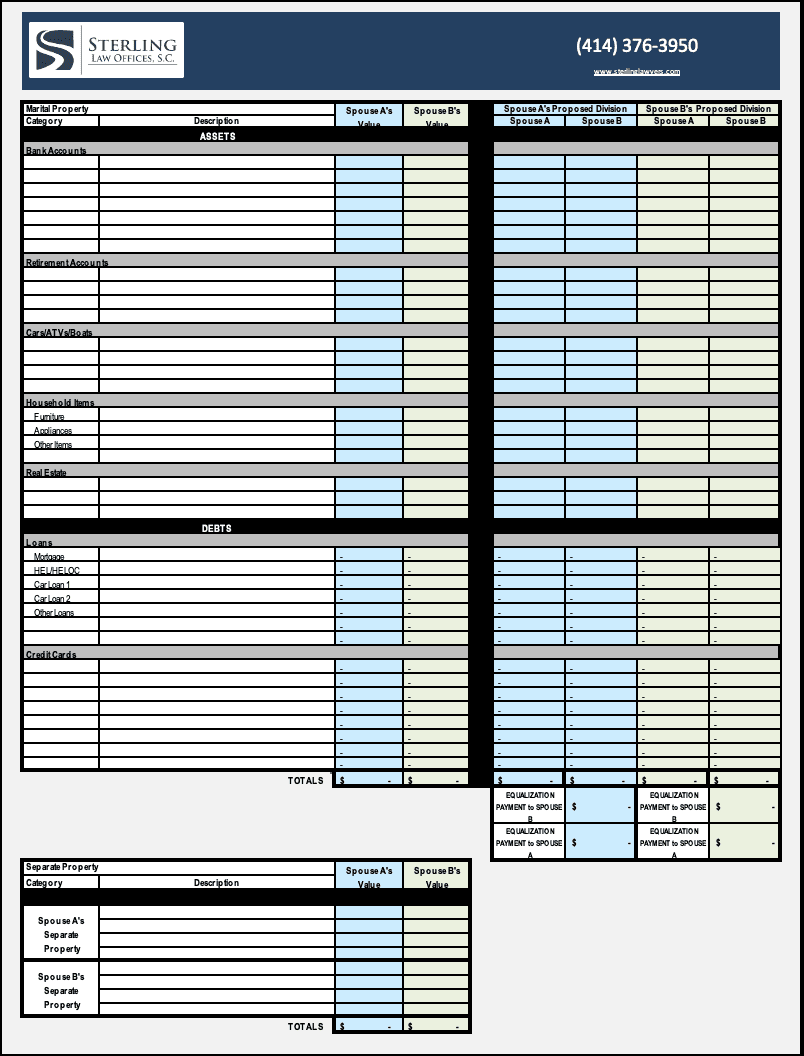Wisconsin Property Division Worksheet
In a Wisconsin divorce, all forms of property either need to be split or go to one party. Property includes both assets and debts. Use the below property division worksheet for splitting assets and debts in a divorce. The worksheet can be used electronically or printed.
Divide Marital Property
After spending hours and hours wondering how things are going to look after the divorce, you certainly have dreams of the way things will end up.
You also certainly have hopes for which things you’ll get to keep after property division. So, use the below worksheet to record how you want to divide the assets and debts
Why the Worksheet Matters
The worksheet is meant to act as a framework to organize your thoughts. It lays out the main assets and debts divided in the property division process. The worksheet can be used as an individual or by both parties. Each party will have different expectations, but the goal is to find a middle ground to agree on.
Based on Wisconsin marital property laws, there are very few non-marital assets, which do not get split. There is space on the worksheet for these assets at the bottom under “Separate Property.”
Guide to the Worksheet
Some terms in the property division worksheet are not clear without a definition. For this reason, the list below defines the terms used within the worksheet:
- Marital Property = Any assets or debts acquired or jointly used in the marriage. (Also called community property.)
- Assets = Any additions to the marital estate whether they are accounts or physical property.
- Bank Accounts = Any personal or joint accounts such as checking, savings, or money market accounts. This also includes offshore bank accounts, health savings accounts, and investment accounts.
- Retirement Accounts = Any personal or joint retirement accounts such as a pension, 401k, or IRA.
- Real Estate = Any buildings or land owned and used for personal, business, or rental use.
- Debts = Any subtractions from the marital estate whether they are loans or another form of debt.
- HEL/HELOC = Home equity loan/home equity line of credit.
- Separate Property = Any property that is outside of the marital estate and owned by only one party. (Also called individual property.)
- Equalization Payment = If one party has a greater net positive than the other, they can pay the other party a cash payment to equalize the division.
For Immediate help with your family law case or answering any questions please call (262) 221-8123 now!
How the Worksheet Works
The below instructions assume the document is being used on a computer, phone, or another device.
- Download the document and save it to a place where it can be found again easily.
- Begin in the Marital Property section (left). Go down the list and fill in as many lines in each category as you have things in that category.
- In the Assets section, use the columns labeled Spouse A's Value and Spouse B’s Value to write the values you and your spouse think each line item is worth.
- For Furniture and Appliances write the amount all the furniture is worth. Or many people decide not to worry about the smaller items and divide those up on their own.
- In the Debts section, again use the columns labeled Spouse A's Value and Spouse B’s Value to write the amount you and your spouse think each line amounts to.
- In the Debts section, each spouse's value box includes a negative “-” symbol. When a number is typed next to the negative, it will show in parentheses “$ (200.00)” after the cell is clicked out of. This is to show that the number is subtracted rather than added.
- In the Separate Property section (bottom), follow steps 1 and 2 for any property belonging to only one party.
- For any property that parties disagree on the worth of, try to talk through it and come to an agreement.
- In the Proposed Division section (right), each party writes the dollar amount that each party will take of each line item.
- For items that only go to one person, simply put 0 in the other person’s column.
- When one party ends up having property that is worth more than the other, an equalization payment can be made. In an equalization payment, the party with the greater value pays the other party half of the surplus amount.
If parties disagree, they can try to work it out, attend mediation, or let the court decide. When parties cannot agree on their own, an attorney from Sterling Lawyers can help in a variety of ways. Parties may disagree on things such as who gets something, how much something is worth, or whether something is marital property.
Not Enough Lines on the Worksheet
When the lines provided are not enough, there are two solutions. If you’re on a computer or device, you can add another line. Do this by right-clicking on the left side where each line is numbered, then click Insert or Insert Row.
If you cannot add another line in that way, you can write it in on another unused line. If you do this, make sure you use a line in the correct section, so the value is added or subtracted correctly.
Frequently Asked Questions
How do you fairly divide assets in a divorce?
The definition of fair is dependent on the specifics of your situation. Property division is split based on the property division laws of wisconsin. Both parties have different things they want, so one party may think it’s worth it to keep the dog and let the other party keep the car.
Are assets always split 50/50 in a divorce?
Wisconsin is a community property state, so the state believes property should be split evenly between both parties. However, there are certain assets that do not get split because they are individual property.
What assets do you split in a divorce?
Marital assets, which are the vast majority of assets, are split in a divorce. Some that are not marital property are assets acquired before the divorce and inheritances.
How are assets divided in a divorce in Wisconsin?
Assets are split 50/50 in Wisconsin. Parties first have the opportunity to come to an agreement on their own. If they cannot agree on how to split up the marital estate, the court will decide for them.

